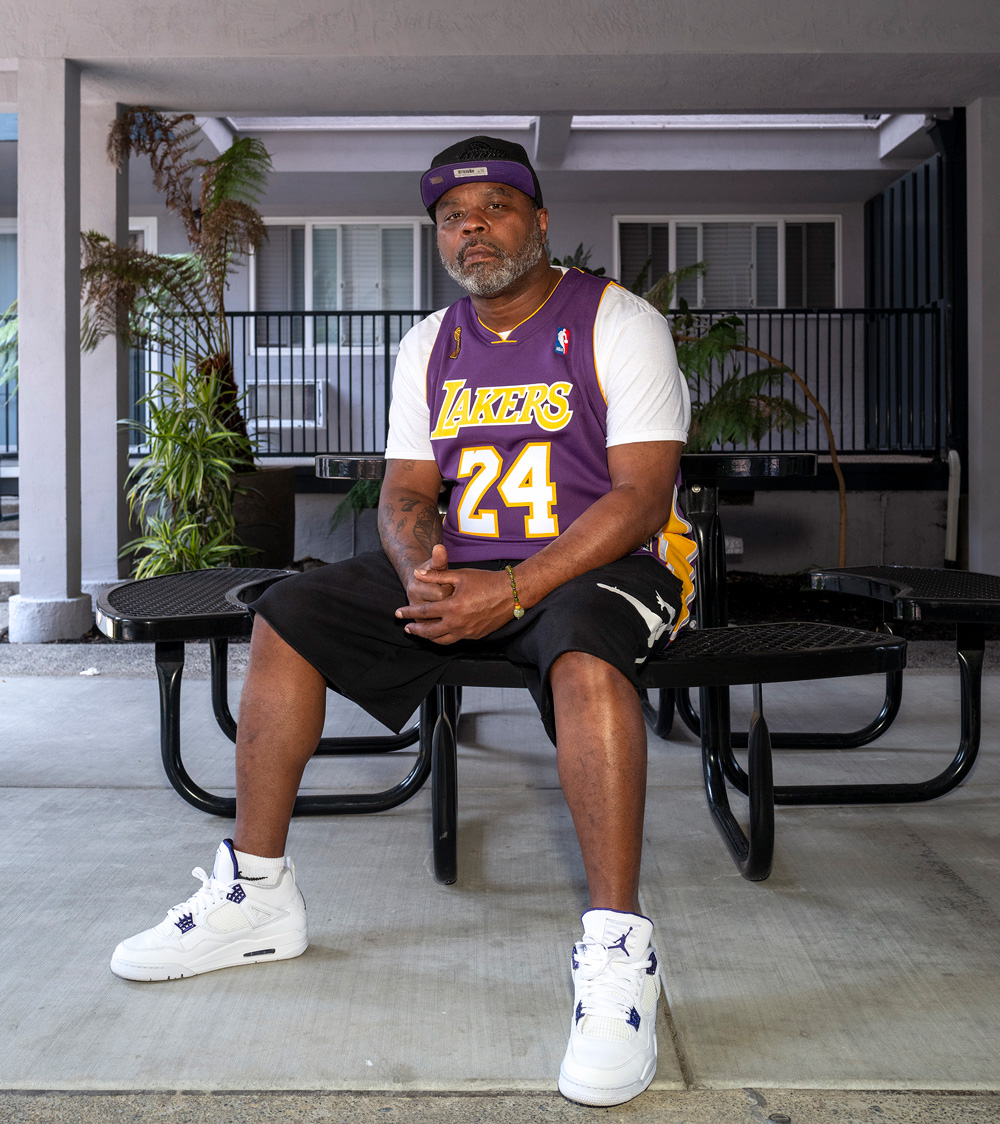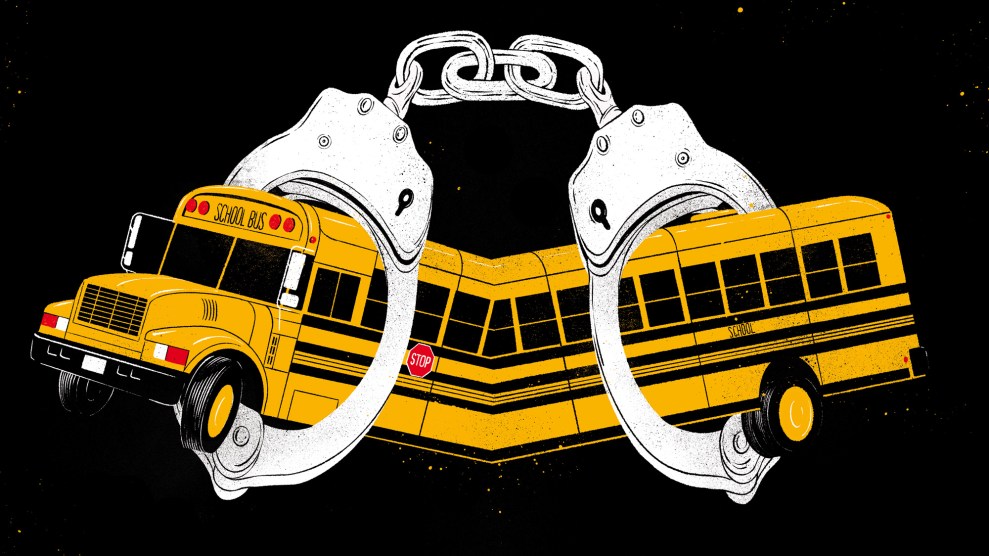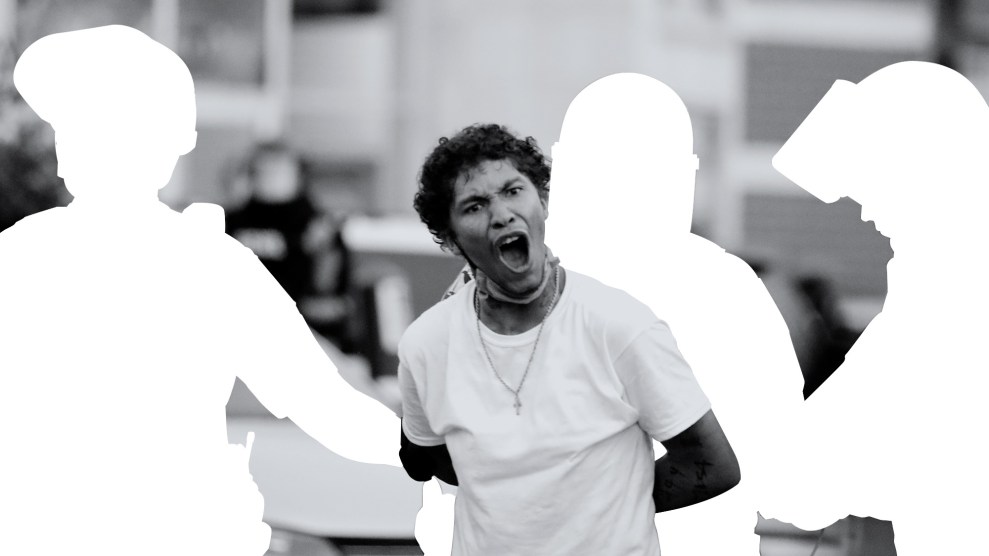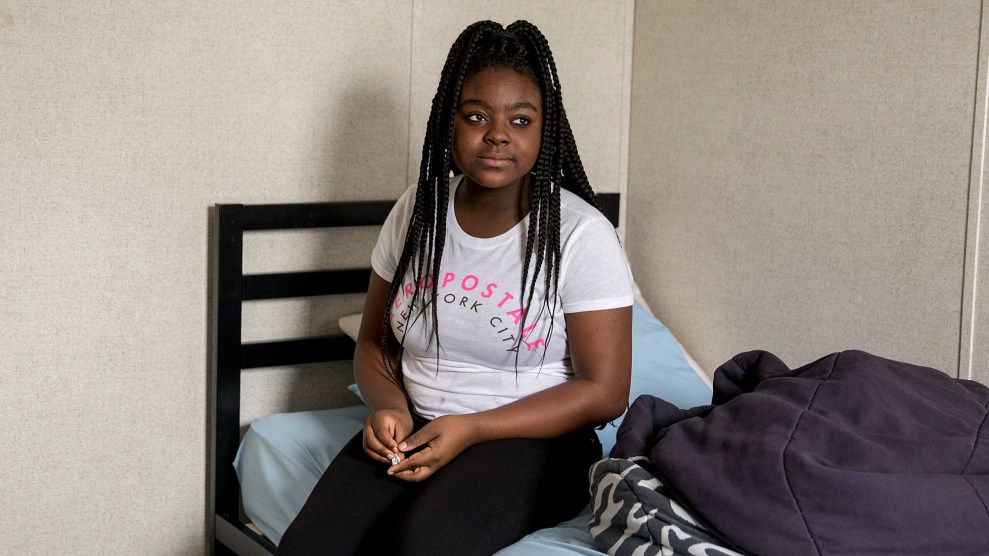When the phone rang at 7 a.m. on a January morning in 2010, Eric Butler learned that his sister had just been murdered.
He had four sisters—“I’m the only boy in a sea of girls”—and 29-year-old Lanell was eight years younger than him. She’d also fled New Orleans after Hurricane Katrina, to Florida. There she met a man, “the most popular young guy on the block. This cat was a drug dealer. And I guess he was good at it. Because he made a lot of money. But he became controlling, really, really fast. He started to hit her. And one night she said she was going to leave him. So he beat her up pretty good. And the kids are there.” Lanell had six children. “After he beat her up and he’s in this drunken stupor, he rapes her. When he goes to bed, she sneaks out of the house. She MapQuests her way back to New Orleans.” This was before GPS navigation was common, “so she had to get like a physical printout. And he wakes up and realizes that she’s gone. Looks on the computer and he can see where.”
Lanell drove her children to the home of one of her sisters. “She’s got it all planned out. She’s going to register the kids into the elementary school, which is right across the street from my sister’s apartment complex.”
“He knew the address. He just stands right outside. And he spots her walking the kids to school.” Lanell saw him, panicked, saw a driver outside the complex, and forced herself into the car’s passenger seat, screaming, “This guy is trying to kill me!” It was too late. “He shoots her in the face, in front of the kids.”
When Eric got the call, he’d just moved from a job as a mediator for neighborhood and gang disputes to doing restorative justice in the Oakland, California, school system. Although we normally think of restorative justice as an alternative to prison sentences, schools are also exploring how to resolve conflicts between kids without expulsions and arrests or violent encounters with security guards or school resource officers (i.e., cops stationed in schools). The idea is to intervene before student conflicts crescendo into violence, instead of the standard approach of doling out punishment. The argument for this change has taken on new urgency as school districts across the country have canceled contracts with police departments in the wake of George Floyd’s killing and the subsequent nationwide wave of protests.
But for Eric, the news of his sister’s murder pushed all his training out of his mind. “I never felt the urge for revenge like I did in that moment. It felt so personal.”
Eric is a sturdy, compact man with diamond stud earrings, his closely cropped hair and beard flecked with gray. He usually wears a baseball cap and always has some Louisiana in his voice. You can still imagine him, even at 46, throwing off tacklers as a star running back who eventually spent two years with the Indianapolis Colts’ practice squad.
His youth was stormy. His mother adopted Lanell and another child of a cousin who’d died; she had a boyfriend who beat her; and as a boy Eric was sexually assaulted. His father abandoned the family. When Eric played football in high school, his dad “never came to a game. It still takes a piece of me away.” Eric has never married, but has several children, the first born when he was still in high school. He estimates that in his 20s he was jailed 30 times, the longest for 22 days. After his time with the Colts he spent years waiting tables. Then came Katrina, floodwaters that almost reached the roof of his two-story New Orleans apartment building; mass death and devastation throughout the Black areas of the city; and the need to begin anew in Oakland.
When Eric heard that his sister had been shot by her abusive ex-boyfriend, “It almost felt like he was taunting me. It was like he was saying, ‘I killed your sister and there ain’t nothin’ you can do about it.’ And, in my head, my answer was like, ‘Oh, I can definitely do something about it.’”
He immediately got on a plane for New Orleans. There, he found his mother in shock. “My mom didn’t greet me. She was stuck. She didn’t know how to feel. The house is crowded. Some of my friends are there from the old neighborhood.” They talked of revenge. “They’re like, ‘Well, whatever we have to do, we’ll do it.’”
One had recently finished a prison term for killing someone when he was a juvenile. Talking with them, Eric says, “I’m getting high off the idea of revenge. Coming up with clever things that I can say while getting revenge, like some movie shit. Like Boyz n the Hood.”
But the murderer was already behind bars. “The state boys got him.” That left Eric and his friends even angrier. “So you want to rumble, but there ain’t nobody to rumble with. I feel like I want my quart of blood. I deserve to get some revenge. Her kids deserve not to cry. His kids deserve to cry too. His mom should be feeling the same thing my mom’s feeling right now.”
Two hours after Eric arrived at his mother’s home, his cellphone rang. “It’s a Florida number. I answer the phone. ‘Is this Eric?’ I say, ‘Yeah.’ She says, ‘I am the mother of the person that killed your sister. I want to come and see your family.’ And she’s in Florida. She’s going to drive five hours to get to us.”
Still inflamed with rage, Eric and his friends spun wild fantasies of revenge. One plan featured a nearby swamp with alligators. “So the idea was throw her in there, and there goes the evidence.”
The idea of restorative justice is not new. Elements can be found in some indigenous societies and, in some capacity, in the legal systems of a few countries, including Canada, New Zealand, and the Netherlands. But amid our national reckoning with systemic racism and a punishment-oriented legal system, it’s an approach that’s gaining steam in the United States. Traditional justice asks what law has been broken and demands retribution. Depending on whether you robbed a store or killed somebody, the penalty can range from a jail term to execution. Restorative justice, by contrast, asks: Who has been harmed? How? If there is a perpetrator and a victim, could one make amends to the other? Is there room for mediation? For an apology? For forgiveness? For acts of service that would make victims—and the communities they are part of—feel healed?
Reform-minded prosecutors are now cautiously testing this approach in San Francisco, Philadelphia, Brooklyn, and elsewhere. Restorative justice is not easy to put into practice, because our entire legal system is based on the idea that for every crime there must be a punishment. And what is that but, writ large, the age-old human thirst for revenge?
That desire was exactly what Eric was feeling when the murderer’s mother arrived at Eric’s mom’s house. “And she pulls up.” Eric was looking out the window. “And my heart starts beating really fast. I’m afraid to tell my friends that she’s there. Man, she’s about this big!” He holds his hand at chest height. She seemed to have dressed in a great hurry, as if to lose no time in getting to New Orleans. “She’s like the cutest little old lady. She has on a muumuu. Like an old lady dress that old ladies sleep in or walk around the house in. Like a robe. And she’s lost some of the buttons. So she has to hold it together. She has on flip-flops. She’s scooting up the driveway. Before she can knock, I open the door. She looks at me and her eyes are welling up.”
“And then she takes her hand and moves me out of the way. So she can see my mom. This woman walks up to my mom. And she gets on her knees. And she says, ‘I’m the mother of the person that killed your daughter. And I belong to you.’ Everything negative in this room—she just sucked all of it out.”
“My mom stands up. And she stands this woman up. And they just start hugging. And they’re crying and sobbing. And, through the sobbing, you can hear my mom say, ‘You was forgiven before you came here.’”
“The room is silent. Except, one of my friends says, ‘Y’all feel that?’”
I first became curious about Eric through watching Circles, a powerful documentary by Bay Area filmmaker Cassidy Friedman, which covers his work at Ralph J. Bunche Academy in Oakland, the city’s last-chance high school for students expelled from other schools. All too often, the pattern of suspension and expulsion would repeat there too. “Before starting this journey,” Betsye Steele, Bunche’s principal when Eric worked there, said at a showing of the film, “I was known as the Suspension Queen.” But she was open to trying Eric’s approach, and it worked: The graduation rate at Bunche Academy had been 68 percent. Once restorative practices were embedded in the school, it rose to 92 percent. Eric still occasionally advises staff members at Bunche, but in the last few years he has begun consulting for school systems around the country.
Since the early 2000s, hundreds of American schools have experimented with restorative practices, and an array of research shows promising results. Just looking at suspensions, for example, schools using restorative practices were able to reduce the number of days students were suspended by 16 percent in 22 Pittsburgh schools, and the number of suspensions by 44 percent in Denver, 77 percent in Minnesota, and 84 percent in one class of Texas sixth graders. Restorative practices work so well, Eric says, because they “make us ask questions like, How would we want to be treated in a situation like this?”
School principals, unlike prosecutors, don’t have to run for office, and it’s obviously easier to change how you deal with a fistfight between eighth graders than with an armed robbery. But the school and justice systems connect, and both are stacked against people of color: According to the Department of Education, Black students are suspended and expelled at three times the rate of white students. And students who are expelled or suspended then fare much worse outside of school. A study in Florida, for example, found that students who had been suspended were twice as likely to be arrested.
I’m in Selma, Alabama, one morning last November. It’s been almost 10 years since Eric’s mother and the mother of his sister’s killer embraced. A mile and a half from the Edmund Pettus Bridge, where state troopers and a sheriff’s posse attacked civil rights marchers and fractured John Lewis’ skull in 1965, and just beyond a sign marking the site of a doomed Confederate cavalry position overrun by Union troops, is the R.B. Hudson middle school, where, with support from two local nonprofits, Eric has been hired to train teachers and staff in restorative work. In an empty classroom, he is arranging chairs for a discussion when the door flies open and a burly security guard bursts in, his massive hands grasping the arms of two boys. The guard muscles the boys into the room and stands them in opposite corners, ordering each to face the wall.
One of the boys is crying and runs out of the classroom. Eric, very distressed, follows him into the hallway and brings him back, saying gently but decisively to the security guard, “We can’t shame him like that.”
Eric already knows one of the boys, an eighth grader I’ll call Andre (I’ve changed the names of all children in this story), and finds out the name of the one crying, Anthony. In talking to each separately, he learns that a squabble between them was broken up by the guard. Eric sits them down facing each other and says, “You guys know each other?”
The boys nod. Eric asks each about the other, “What’s his name?” They respond with first names only. Eric says, “I want first and last names…You gotta knoweach other, man, instead of fighting. Instead of being punished, we’re gonna learn how to talk to each other. What I see is two Black men. We fight each other over and over again. And at the end of the day we can’t even say what it was about.”
He asks each of them how it felt when they were stood with their faces to the wall.
Anthony says, “Like a little kid.”
Andre says, “Jail.”
The three of them talk out what the fight was about. Finally, the two boys shake hands.
The hulking security guard is listening to all this. It’s clearly foreign to him. Eric rehearses each boy in apologizing to the guard: “Now stand up. Walk over there. You gotta look into his eyes. Squeeze when you give a handshake…uh-huh, eye contact!” Then: “Nice job, young man!”
The murmurs of apology are soft. But it’s the guard himself, smiling broadly, who initiates a handshake with each boy.
Watching this encounter is Mark Myles, a 38-year-old Black native of Selma. A veteran political organizer—most recently in Stacey Abrams’ campaign for Georgia governor—Mark is funded to apprentice himself to Eric, so Mark can continue doing this work in Alabama when Eric’s contract with the school district ends. There are formal courses in restorative practices, but the best way to learn is by watching somebody do it. Like Eric and many who get into this line of work, Mark did not have an easy childhood. “I had an absent father. I took a lot of my frustrations out on my teachers.” Before he got his GED, “I was in a gang. They kicked me out of high school. I got suspended from every school I ever went to.” He has a hard time pinpointing what made him turn around in his mid-20s, but says, “Restorative justice is a blessing for me. If I’d had it back then, I would be a different person.”
After the guard and the two boys leave the classroom, Eric says to Mark, “We’re trying to teach the staff something they don’t always want to learn. It’s much harder to teach adults than kids. Sometimes the idea is to teach the kids, and the adults follow.” Later, he tells both of us, “They all grew up in a culture that’s punitive. Because this is Alabama. However, you can be strict without being punitive.”
Over the course of a week, I follow Eric through the school. Selma is about 80 percent Black, its schools even more so. At R.B. Hudson, the city’s only public school for seventh and eighth graders, almost all of the roughly 400 students, as well as most teachers and staff, are Black. White students go to private schools.
To spend the day at Hudson is to be reminded of how many schools are partly custodial. One meeting room is referred to as the “command center.” The dress code specifies no shredded clothing; pants (“absolutely NO SAGGING!”); and book bags (“SEE THROUGH MESH OR PLASTIC ONLY!!!”).
Students pass through a metal detector to enter school. Every teacher or staff member has a walkie-talkie, and the security guard has two, one on each hip. They blare continuously: “Officer Griffin, what’s your location?…Ms. Alexander, are you on seventh grade hall?” Sometimes the squawks are fragments of messages about a disciplinary or behavior crisis: “…and he refusedto go,” or “…but he ran downstairs!” Teachers and staff sign off with “10-4.”
Students say “No, sir,” and “Yes, ma’am,” and if Eric introduces himself to a teacher and asks her name, it will be “Ms. Thomas.” He cuts a very different figure. Cruising the hallways, with his earrings, baseball cap, sneakers, and Beats headphones pumping a mix of Stevie Wonder and ’90s R&B, he calls out to students and gives them hugs, fist bumps, high-fives. “Don’t ‘yes, sir’ me. My name’s Eric!” “How y’doing, cousin!…My man!…How’s my homie?…What do you wanna be when you grow up? Maybe I’ll tell you what I want to be when I grow up!” Sometimes he’ll roll up his sleeve and show off his tattoo: “Find Something Truly Worth Dying For And Live For It.” This is only his second week at Hudson, and the teachers are clearly not sure what to make of him.
Some of the work Eric does is on the fly, as with Andre and Anthony. But he also holds scheduled talks with groups of students. At one, he asks, “How many know someone who’s been in jail?” Almost all kids raise a hand. “How many know someone who’s been murdered?” About half put a hand up. In another session, he spends an hour with 17 boys whom he seats in a circle. “As adults,” Eric says to the boys, “we haven’t given you reason to trust us.”
They look bewildered. This is not how teachers talk. Their teacher isn’t here, but on her desk, her walkie-talkie is still squawking with its 10-4s. Eric tells his own story with an eye for something that resonates with 12- and 13-year-olds. “I got four sisters. I’m the oldest. When I was a kid, what do you think my job was?”
Many voices reply, “Protecting them!”
“Protecting, right? So every time they got into a fight, Igot into a fight. So I got into a lot of fights. So when I got a phone call saying my younger sister was murdered, my heart was broken.” Students who were fidgeting or talking stop. He fills in the details, then asks, “Should I forgive him?”
“No!” come the voices. Eric explains that the man was already in jail. A boy voices Eric’s own reaction: “If you can’t get to him, you want to kill someone closest to him.”
Right, Eric nods. “This dude killed my family.” When he gets to the part about the plan to take revenge, he emphasizes how hard it was to back out. “You know how when you about to do some bad stuff you get nervous? And you don’t want to do it no more? But you can’t tell your partners—because you already told them you’re gonna do it?” The boys nod.
The impact of his story, however, is rudely blunted when a boy enters the room and takes a seat, glowering. A few minutes later, the door opens again and another comes in and collapses, face down on a desk, pulling his jacket over his head. Teachers are clearly exiling misbehaving students to this classroom. Each time, it shatters the mood. Eric confers with Mark and they agree to tell the school administration their sessions can’t be used as detention.
As the week goes on, their caseload grows. With a coach, Eric tries to negotiate the reinstatement of a girl who got kicked off the basketball team. To one student, following up on some problem from a few days ago, he says in the hallway, “I’m gonna quarterback this thing, but I need you to be my wide receiver.” In the gym, Mark seeks out a boy who had left a note threatening death to several boys who’d bullied him. Eric pulls me aside while Mark talks to him alone, “because I think this kid is really fragile.” As a seventh grader, he may be less likely to follow through on his threats right now, but “he was disrespected. That’s how it started at Columbine.”
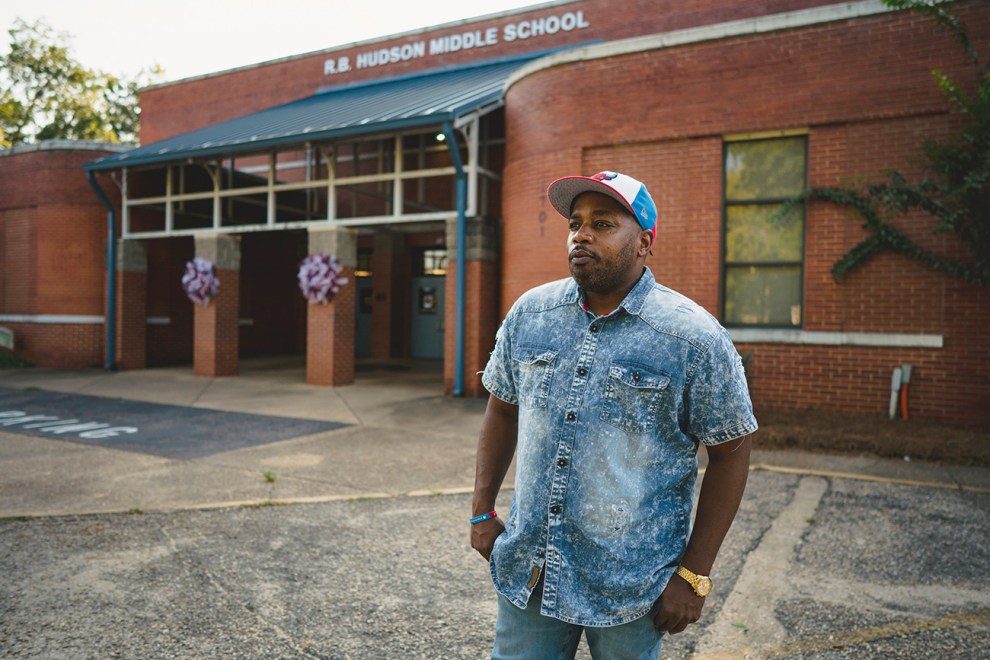
“Restorative justice is a blessing for me,” says Mark Myles.
Nicole Crain
Eric uses each intervention as a lesson, describing it in detail to the next person he encounters. To a surprised mother waiting to talk to the principal, he reels off one such incident, telling her, “Restorative justice is about love. To be honest, there’s not much love shown in schools. But it’s better than being punitive. How do you choose who gets paddled? The answer is, you don’t do it.”
I watch as he deploys his approach with two girls, Kaya and Clarissa.
First, we’re alone with Kaya. “Let’s go back over it,” Eric says. “What happened?”
“Got in a fight.”
“How?”
“She said somethin’. I said somethin’ back,” she says, with a face that seems to expect punishment.
“You’re not in trouble,” he says. “We got your back…You got a sad look on your face.”
Kaya relents and describes winning the fight.
“Okay,” Eric says. “You win the fight. You got her on the ground. What do you win? You get a trophy?”
“It’s the feelin’,” Kaya says. “You know somebody’s been pickin’ with you for the longest time. You beat them up. It’s the feelin’ you get.”
“When you smile,” Eric says, “you light up the whole room. But when you fight, we never get to see that. We see your fight look. Check it out! Do your fight look…Now do your proud look! Don’t it feel so much more comfortable? But I gotta admit, there’s something to it, the feelin’ you get, the rush you get, when a fight is happenin’. What we want to understand is why that happens.”
Kaya mentions that she’s got four dogs—two pit bulls, a Shih Tzu, and a German shepherd.
“You mean to tell me,” Eric says, “that three different breeds of dogs can get along together, but two human beings can’t?”
Both girls have been sentenced by a teacher to swab off tables in the cafeteria, where we catch up later. They are studiously ignoring each other, so Eric makes each look at the other while he asks questions.
“What brings you joy?”
“Singing!” Kaya blurts out.
More questions follow:
“What makes you sad? Mad? If you could change anything about the world, what would it be?”
After each answers, he says, “Now you know some things about each other.” When he leaves, both girls are smiling.
When the man who murdered Eric’s sister was sentenced, the judge “asked us, Did we want to say anything? And I said, ‘If this question is about permission to take this man’s life, if I have the authority to not give you that permission, I say no, you can’t take his life.’ And to him I said, ‘It feels good to forgive you. And I hope that while you are doing time, that you learn to forgive yourself.’”
“They asked him, Did he have anything to say? He looked at me and he said, ‘Bitches need to learn their place.’ Usually when I tell that story—especially to young men, they say, ‘It must have been hard for you not to jump over the…’ It wasn’t. Like that didn’t exist inside me no more. What I gave him instead was, ‘Man, I still forgive you.’ And now he’s got to go back inside his cell with all of that. And, after that, he’s got to wish that he had an opportunity to say, ‘I thank you,’ and ‘I’m sorry.’ But he’s probably never going to get that opportunity again.” The murderer was sentenced to life without possibility of parole. “He’s probably going to be on a chain gang. Which sucks.”
Back at R.B. Hudson, we are in the office of Dr. Valerie Lewis, the upbeat assistant principal, who has another dispute to be resolved, this time between a tall girl named Lucille, with long dreadlocks, and a boy who retreats into his hoodie, murmuring his name so softly that Eric and Mark and I never catch it. Lewis looks on as Eric tries to tease out exactly what happened. The two were in a fight, which escalated. Lucille threatened to have her family beat him up and shoot up his house. He said, “I got people I can call, too.” To dare him to do that, she gave him her address. He replied in kind, but admits now he gave her a fake address.
Eric begins by asking the two, “What is something you need from everybody in this space?”
Lucille says, “Patience.” The boy, “Respect.”
“So he said something bad to you,” Eric says to Lucille. “You had to top that by sayin’ somethin’ badder. What was the result?” Then, to both of them: “What could happen to solve your conflict? What d’y’all need?”
They are not used to being asked such a question, and have no answers.
Eric goes on, to her, “So you want your brother to beat him up so bad that it’s gonna make him want to talk to you no more? That’s what you’re thinkin’? What if that doesn’t work?”
Lucille: “It’s gonna work.”
Eric points out that she could go to jail if she follows through on her threat. She seems unmoved.
The boy has a cousin in jail. Eric asks them both if they think they could handle jail. Lucille says she’s been in juvenile. There is a heaviness in her voice.
“That’s not jail,” Eric says. “That’s not even close. You can be the toughest one in juvenile hall. You will never be the toughest one in big-girl jail. Trust me. There’s gonna be a girl named Cookie. She stand by the phone. That’s herphone. Cookie’s big. Cookie’s like 6-foot-3. She controls that phone. You pay for your call and then you gotta pay Cookie to use that phone. And Cookie not playin’ with you, man. So you’re either gonna do stuff for Cookie or you’re gonna see them hands of hers, every single day. You ready?”
Mark adds quietly, “I been to jail.”
At the side of the room, alerted by a text message to some problem, Dr. Lewis speaks into her walkie-talkie, “Officer Griffin, are you on eighth grade hall?”
Eric continues, “You don’t see your family no more. Every time you see your momma, or whoever you love, when they leave, it’s gonna break their heart.”
Lucille says she doesn’t care: “The day my mom walked out on us was the day I stopped caring.” It turns out Lucille lives in a foster home.
An hour is up. Bells ring. Both Lucille and the boy leave. Her last statement hangs over us. Suddenly Dr. Lewis reaches out and pulls Eric, Mark, and me to her in a tight circle, bows her head, and says, “Let us pray.” She puts her arms on our shoulders. “Lord, reach down and help this poor girl. Show her your mercy. Lift her up. Save her.” She continues for several minutes. Afterward, Dr. Lewis says to me, “I cry all the time. You can’t do this work without cryin’. Adam, you say you ain’t a prayin’ man, but pray for us.”
On Friday, at the end of an intense week, Eric and Mark both look drained. “It’s kind of like playing football,” Eric told me a few days earlier. “You don’t realize how exhausted you are until afterwards.” We’re outside the school’s front door, amid the noisy crowd of students spilling out of the building to head home. Eric is pacing up and down the sidewalk in tense frustration about something that happened a few minutes ago.
A boy had been “mouthing off” at a teacher, who in turn called in the boy’s pastor to administer a beating. “The pastor of a church came in to beat a kid,” Eric says, “and they gave him the equipment—the board—and they wonder why a kid goes out of control! The teacher said he needed a board and a witness. He asked me to come along. When I refused, he called me a Yankee!”
“If you don’t have a dad in the family to do this”—by Eric’s estimate, most of the children he works with don’t have a father in the home—“you have a pastor do it. So the kid is learning: The way I deal with conflict is to hit somebody. And even if I can’t do it, then somebody else will. How do they expect us to do restorative justice when they come and beat a kid?”
Corporal punishment is legal in Alabama public schools, as it is in 18 other states, mostly in the South. To Eric, this echoes the days of slavery. “It’s on your backside. You have to turn your back to the person that’s disciplining you. You don’t get to look at them. It’s a shaming process. And more often than not, it’s done in front of others” to make them think, “What could happen to me if I get out of line? That was the slave master’s idea of how to maintain control. And it’s the exact same idea in the schools. We’re not really trying to teach. We’re trying to maintain control. But the real message is, ‘I’m doing this because I’m angry.’”
School officials are not as upset about the beating as Eric wants them to be. “About 75 percent of the teachers get what we’re trying to do. But only 20 percent are willing to actually do it. They don’t say it, but their body language says it all.”
We head to a late lunch along a bleak highway, where dollar stores and loan shops are interspersed with fast-food joints. At one, we sit over plates of fried rice and chicken wings. A few Hudson teachers in the takeout line wave at us, cheerful because a holiday weekend is coming up.
Eric is still fuming, his anger leavened only by a wry chuckle at the irony of one Black Southerner calling another a Yankee because he wouldn’t participate in a beating. All week long he’s been talking to Mark and me about the “punitive culture” that surrounds us, about its roots in slavery. Two giant TV screens flank either side of the restaurant. On one is Jerry Springer. On the other is Live PD, the reality show that was later canceled amid racial justice protests. At this moment, a white police officer is slapping handcuffs on a Black man.
“There!” Eric jabs a finger at the screen. “That’s what we’re talking about.”
When I checked back in a few months later, Eric was feeling more optimistic that the teachers he was working with were starting to “get it.” Not long after that, however, COVID forced schools everywhere, including Hudson middle school, to go online. By that point, however, there was already one sign of his impact: referrals from Hudson to Selma’s juvenile court system had dropped sharply. The principal says they’ve cut back on paddling, and no longer make kids face the wall when being disciplined. Eric has been busy during the virus shutdown consulting with school principals in different cities, but “most of the work I was doing in Selma was face to face, and almost has to be face to face.” Once things are back to normal, the nonprofits funding him and Mark plan to have them train others in restorative justice practices—and to expand that work to other schools, including the city’s high school.
He’s hopeful that the reverberations from George Floyd’s killing will have “a good impact” on restorative justice: “I think there absolutely is an increased appetite for this work now.” He’s happy to see school districts around the country canceling contracts with police forces—“It was a horrible idea to have them in there in the first place”—and hopes criminal justice reforms will go deep. “The point isn’t that it’s a black-white issue. The common enemy is the judicial system. We’re affected by it more than others, but everybody’s affected by it.”
Paradoxically, it’s the worst experience of his life—his sister’s murder—that gave Eric an opportunity for optimism. “I haven’t gotten to the point where I love him,” he says of the killer, “but I love the fact that he taught me that I will never, ever hurt another human being physically again. That used to be the opposite. My attitude about hurting people was ‘If you step on my foot, I’m going to try to paralyze that whole side of your body.’ I can’t imagine thinking like that now. And I believe that he’s going to get it one day. You can’t run from yourself forever.”
